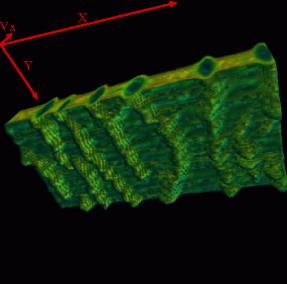
(Phase-space image of electron tornadoes: The x-axis lies parallel to the magnetic
field and the y-axis is perpendicular.)
M. Oppenheim
Department of Astronomy
Boston University
D. L. Newman and M. V. Goldman
University of Colorado at Boulder
Abstract:
Four Earth orbiting satellites have recently measured streams of isolated electric field pulses traveling along the Earth’s magnetic fields in regions as diverse as the auroral ionosphere, the Earth’s bow-shock, and the magnetotail. These measurements result from stable electron density depletions and contain some of the highest electric field energy densities found in space plasmas. In 1D, these depletions result from “phase-space electron holes” where rotating trapped electron vortices in (X-Vx) phase space are contained by a strong positive potential. In 2D, electron holes form tornadoes when viewed in (X-Y-Vx) phase space. This poster presents some images of simulations of phase-space electron holes and tornadoes. In addition, one may watch computer animations of electron phase-space tornados.
Conclusions
Electron phase-space tornadoes commonly occur in energetic regions of the ionosphere, magnetosphere, and near-Earth solar wind. Studying this nonlinear plasma phenomenon using massively parallel simulations has taught us that these structures are fundamentally unstable and convert their energy to a particular plasma wave, the electrostatic-whistler wave. By understanding this evolution, we hope to further our understanding of dynamics in the space plasma environment of the Earth.
Video Segments

1-D Vlasov Simulation of Electron Phase-Space Holes
Electron phase space holes in 1-D engage in some fascinating and complex dynamics. Below are frames from an animation of a two-stream instability evolving into 2 electron holes which then merge into a single hole . These images show phase space as a surface plot. The vertical axis is v and the horizontal axis is x. The system starts with two counter streaming electron distributions which quickly go unstable and form electron holes. As the holes merge, smaller holes are spun off. These small structures disintegrate after a few encounters with the large electron hole. This final hole remains stable for thousands of plasma periods.
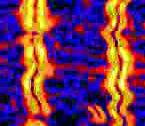
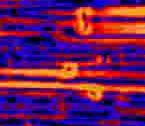
2-D PIC Simulation of Evolving Electron Holes
The horizontal (x) axis lies parallel to the geomagnetic field while the vertical (y) axis lies perpendicular. The pairs of mostly vertical yellow lines seen at early time represent the electric field signatures of the electron tornadoes. As time progresses, they evolve into the little orange circular structures seen at late time. Simultaneously, the orange horizontal lines develop which show the existence of electrostatic-whistler waves.
This Particle-in-Cell simulation required 16 hours using 64 processors of a SGI Origin 2000 computer.
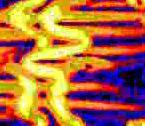
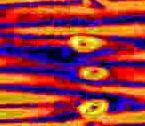
2-D PIC Stability Test of 1-D Electron Holes
In order to better understand the origin of the whistler waves and the breakup of the tubes in 2-D, we initiated a PIC run with a set of 1-D tubes and watched the plasma evolve. This shows that 2-D electron tornadoes are fundamentally unstable, and convert their energy into electrostatic-whistler waves. Leaving only stable electron phase-space bubbles as seen by the yellow circles.
Scientific Background
Nonlinear two-stream instabilities as an explanation for auroral bipolar wave structures by M. V. Goldman, M. M. Oppenheim and D. L. Newman in Geophys. Res. Lett., Vol. 26, No. 13, 1821-1824, 1999.
Hardware: SGI Origin 2000.
Software: C++, MPI. Visualization: IDL, AVS.
Graphics programming: Meers Oppenheim, Dept of Astronomy, Boston University, and Kathleen Curry, Scientific Computing and Visualization Group, Boston University.
Video production: Kathleen Curry, Scientific Computing and Visualization Group, Boston University.
Acknowledgments: We would like to thank Los Alamos National Laboratory for allowing us extensive use of their Origin 2000 machines.
